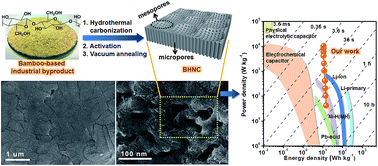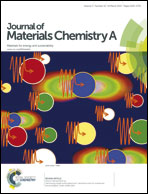Bio-inspired beehive-like hierarchical nanoporous carbon derived from bamboo-based industrial by-product as a high performance supercapacitor electrode material†
Abstract
Bio-inspired beehive-like hierarchical nanoporous carbon (BHNC) with a high specific surface area of 1472 m2 g−1 and a good electronic conductivity of 4.5 S cm−1 is synthesized by carbonizing the industrial waste of bamboo-based by-product. The BHNC sample exhibits remarkable electrochemical performances as a supercapacitor electrode material, such as a high specific capacitance of 301 F g−1 at 0.1 A g−1, still maintaining a value of 192 F g−1 at 100 A g−1, negligible capacitance loss after 20 000 cycles at 1 A g−1, and a high power density of 26 000 W kg−1 at an energy density of 6.1 W h kg−1 based on active electrode materials in an aqueous electrolyte system. Moreover, an enhanced power density of 42 000 W kg−1 at a high energy density of 43.3 W h kg−1 is obtained in an ionic liquid electrolyte system, which places the BHNC-based supercapacitors in the Ragone chart among the best energy–power synergetic outputting properties ever reported for carbon-based supercapacitors.


 Please wait while we load your content...
Please wait while we load your content...